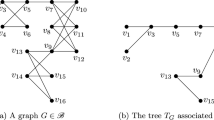Abstract
In the present paper we develop and investigate a novel approach that aims to characterize quantum entanglement by using cross norms. In the first part of the paper we further develop the mathematical theory by determining the value of the greatest cross norm for Werner states, for isotropic states and for Bell diagonal states. In the second part we show that our techniques induce a novel powerful analytical and computable separability criterion for bipartite systems. This new criterion complements the well-known Peres positive partial transpose criterion in several aspects. It is a necessary but in general not a sufficient criterion for separability. We demonstrate the power of the new criterion by evaluating the criterion for a number of important examples. We also demonstrate that the new criterion is able to detect bound entangled states.
Similar content being viewed by others
References
Bruß D. (2002) ArticleTitleCharacterizing entanglement J. Math. Phys. 43 4237–4251 Occurrence Handle10.1063/1.1494474
M. J. Donald M. Horodecki O. Rudolph (2002) ArticleTitleThe uniqueness theorem for entanglement measures J. Math. Phys. 43 4252–4272 Occurrence Handle10.1063/1.1495917
O. Rudolph (2000) ArticleTitleA separability criterion for density operators J. Phys. A Math. Gen. 33 3951–3955 Occurrence Handle10.1088/0305-4470/33/21/308
O. Rudolph (2001) ArticleTitleA new class of entanglement measures J. Math. Phys. 42 5306–5314 Occurrence Handle10.1063/1.1398062
B.M. Terhal K. G. H. Vollbrecht (2000) ArticleTitleThe Entanglement of Formation for Isotropic States Phys. Rev. Lett. 85 2625–2628 Occurrence Handle10.1103/PhysRevLett.85.2625 Occurrence Handle10978123
A. Peres (1996) ArticleTitleSeparability criterion for density matrices Phys. Rev. Lett. 77 1413–1415 Occurrence Handle10.1103/PhysRevLett.77.1413 Occurrence Handle10063072
M. Horodecki P. Horodecki R. Horodecki (1996) ArticleTitleSeparability of mixed states: necessary and sufficient conditions Phys. Lett. A 78 1–8 Occurrence Handle10.1016/S0375-9601(96)00706-2
M. Horodecki P. Horodecki (1999) ArticleTitleReduction criterion of separability and limits for a class of protocols of entanglement distillation Phys. Rev. A 59 4206–4216 Occurrence Handle10.1103/PhysRevA.59.4206
M. A. Nielsen J. Kempe (2001) ArticleTitleSeparable states are more disordered globally than locally Phys. Rev. Lett. 86 5184–5187 Occurrence Handle10.1103/PhysRevLett.86.5184 Occurrence Handle11384452
K. G. H. Vollbrecht M. M. Wolf (2002) ArticleTitleConditional entropies and their relation to entanglement criteria J. Math. Phys. 43 4299–4306 Occurrence Handle10.1063/1.1498490
A pure bipartite wavefunction \(\vert \psi \rangle\) in \({\mathbb{C}}^d \otimes {\mathbb{C}}^d\) with Schmidt decomposition \(\vert \psi \rangle = \sum_{k} \sqrt{p_{k}} \vert \chi_{k} \otimes \eta_{k} \rangle\) is called maximally entangled if \(p_{k} = \frac{1}{{d}}\) for all k. Loosely speaking a bound entangled state is an entangled state that cannot be transformed to maximally entangled pure form by local operations assisted by classical communication (LOCC operations). It is known that any entangled state that satisfies the PPT criterion is bound entangled. Entangled states that are not bound entangled are also called distillable or free entangled.
G. Vidal R. Tarrach (1999) ArticleTitleRobustness of entanglement Phys. Rev. A 59 141–155 Occurrence Handle10.1103/PhysRevA.59.141
E. Schmidt (1907) ArticleTitleZur Theorie der linearen und nichtlinearen Integralgleichungen. I. Teil: Entwicklung willkürlicher Funktionen nach Systemen vorgeschriebener Math. Ann. 63 433–476 Occurrence Handle10.1007/BF01449770 Occurrence HandleMR1511415
A. Ekert P. L. Knight (1995) ArticleTitleEntangled quantum systems and the Schmidt decomposition Am. J. Phys. 63 415–423 Occurrence Handle10.1119/1.17904
R. Schatten (1970) Norm Ideals of Completely Continuous Operators Springer Berlin
N.E. Wegge-Olsen (1993) K-Theory and C*-Algebras Oxford University Press Oxford
R. V. Kadison and J. R. Ringrose, Fundamentals of the Theory of Operator Algebras I & II, (Academic Press, Orlando, 1983 & 1986).
D. Pérez-García (2004) ArticleTitleDeciding separability with a fixed error Phys. Lett. A 330 149–154 Occurrence Handle10.1016/j.physleta.2004.07.059
L. Gurvits (2004) ArticleTitleClassical complexity and quantum entanglement J. Comput. Sys. Sci. 69 448–484 Occurrence Handle10.1016/j.jcss.2004.06.003
O. Rudolph, Further results on the cross norm criterion for separability, quant-ph/0202121 v1.
R. Horodecki M. Horodecki (1996) ArticleTitleInformation-theoretic aspects of inseparability of mixed states Phys. Rev. A 54 1838–1843 Occurrence Handle10.1103/PhysRevA.54.1838 Occurrence Handle9913669
C. H. Bennett D. P. DiVincenzo J. A. Smolin W. K. Wootters (1996) ArticleTitleMixed state entanglement and quantum error correction Phys. Rev. A 54 3824–3851 Occurrence Handle10.1103/PhysRevA.54.3824 Occurrence Handle9913930
P. Horodecki M. Horodecki R. Horodecki (1999) ArticleTitleBound entanglement can be activated Phys. Rev. Lett. 82 1056–1059 Occurrence Handle10.1103/PhysRevLett.82.1056
Author information
Authors and Affiliations
Corresponding author
Rights and permissions
About this article
Cite this article
Rudolph, O. Further Results on the Cross Norm Criterion for Separability. Quantum Inf Process 4, 219–239 (2005). https://doi.org/10.1007/s11128-005-5664-1
Received:
Accepted:
Issue Date:
DOI: https://doi.org/10.1007/s11128-005-5664-1




